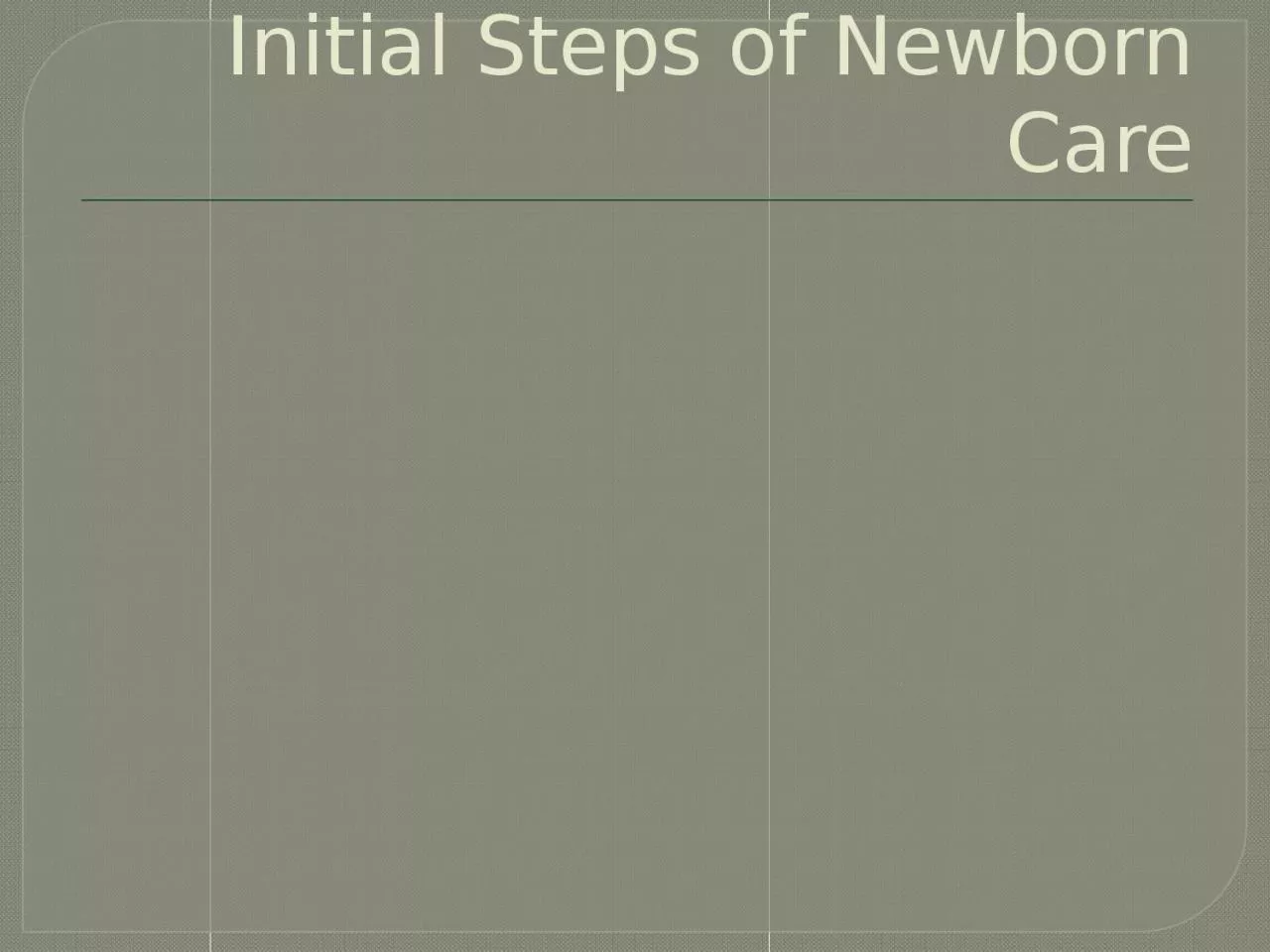

Initial Steps of Newborn Care Rapid Assessment of the NB Initial Steps of NB Care How to determine if additional steps required What to do if baby has Persistent cyanosislabored breathing How to use a Pulse ID: 935531
Download Presentation The PPT/PDF document "Initial Steps of Newborn Care" is the property of its rightful owner. Permission is granted to download and print the materials on this web site for personal, non-commercial use only, and to display it on your personal computer provided you do not modify the materials and that you retain all copyright notices contained in the materials. By downloading content from our website, you accept the terms of this agreement.
Slide1
Initial Steps of Newborn Care
Slide2Initial Steps of Newborn Care
Rapid Assessment of the NB
Initial Steps of NB Care
How to determine if additional steps required
What to do if baby has:
Persistent cyanosis/labored breathing
How to use a Pulse
Oximeter
How to give supplemental O2
When to consider PPV
What to do when meconium stained amniotic fluid present
Slide3Slide4Case 1: Uncomplicated Birth
Healthy woman at 39wks
uncomplicated single pregnancy
Membranes rupture, amniotic fluid clear
RN assigned to baby checks equipment and supplies.
Baby born, FT, good muscle tone, crying
Positioned on mother skin to skin, covered with worm blanket and dried
RN stimulates her.
Cord clamped at 1 min. Color pink
Successful transition to NB circulation
Slide5Slide6Case 2: Delayed Transition
Multiparous
woman at 39wks, active labor and ruptured membranes.
After admission mother develops fever, and given antibiotics
Fetal HR monitoring: Category II
NN resuscitation team called
Introduce team
4 pre birth questions for risk factors
Re resuscitation team briefing
Equipment check
Slide7Case 2: Delayed Transition
Baby born
Poor tone, no cry. OB holds in warm blanket, suctions mouth and nose, stimulates, no change in status, cord cut
Brought to radiant warmer
Position/open airway, stimulate. Tone and respiratory effort improves. HR 120bpm and good BS
5 min
Central cyanosis and Pulse Ox on right hand < minute specific value, so given supplemental O2
10 min
Breathing regularly, Pulse Ox in normal range, O2 stopped
Placed skin to skin on mother and monitored
Team conducts short debriefing:
preparation, team work, communication
Slide8Time of birth and clamping the umbilical cord
Evidence supports clamping at 30-60 sec for most vigorous term and preterm NB
If placental circulation not intact, cord should be clamped immediately
Slide9All newborns need rapid evaluation
1- Term?
2- Good muscle tone?
3- Is baby breathing or crying?
Slide10Initial Steps for Newborn Care
Provide warmth
Position head and neck
Clear secretions, if needed
Dry
Stimulate
Slide11Slide12Provide warmth
Slide13Position head and neck to open airway
Slide14Clear secretions from the airway
Slide15Dry
Slide16Stimulate
Slide17Assess newborn’s response to initial steps
Respirations
If not breathing, or is gasping, proceed to
Positive Pressure Ventilation
Heart rate
100
bpm
Stethoscope
Count number beats in 6 sec, multiply by 10
Connect pulse
oximeter
to right hand, ECG monitor
If HR < 100 Start
Positive Pressure Ventilation (PPV)
Slide18If baby breathing and HR> 100, but
cyanotic: give Oxygen
Cyanosis
Poorly oxygenated blood
Acrocyanosis
Central cyanosis
Pulse
oximetry
Measures
Hbg
saturated with Oxygen
Takes 10 min for newborn to reach normal levels
Slide19Pulse
Oximetry
When resuscitation
Confirm central cyanosis
When giving supplemental O2
When giving PPV
Pre
ductal
: right wrist/hand
Artery to right arm attaches to aorta before the
ductus
arteriosus
Values change after birth
Slide20Pulse
Oximetry
Slide21When is supplemental O2
given?
Oximeter
reading is < target range for baby’s age in minutes
If baby spontaneously breathing
Free flowing oxygen
O2 tubing
O2 mask
Flow inflating bag and mask
T-piece resuscitator and mask
Open reservoir on self inflating bag
If baby not breathing or gasping
PPV
Slide22Free Flowing O2
Slide23Adjusting O2 Concentration
Goal
Maintain baby’s minute specific O2 saturation
Prevent hypoxia and
hyperoxia
Adjust delivered O2 using
Compressed air and O2
Oxygen blender (21-30%)
Flowmeter
(adjust to 10L/min)
Slide24What if baby has labored breathing or persistently low O2
saturation?
CPAP: continuous positive airway pressure
Continuous low gas pressure to keep a spontaneously breathing baby’s lungs open
Baby must be breathing and have HR > 100bpm
Flow inflating bag
T-piece resuscitator with mask
Both tightly fitted to baby’s face
Slide25CPAP
Slide26Meconimum
stained amniotic fluid
Vigorous Newborn
Good respiratory effort and muscle tone
Stay with mother, initial steps
Gently bulb suction mouth and nose
Non-vigorous Newborn
Bring to radiant warmer for initial steps
Bulb suction mouth and nose
If baby not breathing, or HR < 100bpm after initial steps, proceed to PPV
Slide27Case Scenario
You are called to attend a vaginal birth. The mother is in active labor with ruptured membranes.
How would you prepare for this baby?